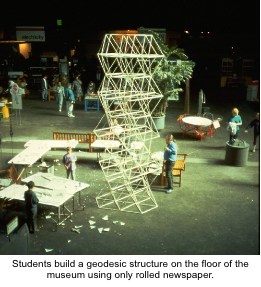| • Are adults who keep up with the forefront of the arts more capable of coping with the other kinds of changes that take place in themselves or in society? It is certainly not necessary to await the answers to these questions before getting started with the discussion. The successful art education patterns that evolved from a panel on Museum Education in the Visual Arts and a panel on The Arts, Education, and Americans* can surely serve as guides to what can be done*. The members of these panels had an extraordinary sense of mission, and they relied on extensive staff work to survey what is happening in the United States with regard to art education. The reports of the panels document the existence of an incredible array of exemplary, inspiring, and often extraordinarily moving projects. However, the dismal conclusion of both reports is that art education for the most part lies at the bottom of the heap. In all too many art museums, the education programs and staff are inadequately funded, relegated to basement rooms, and play fifth fiddle to the curatorial functions of the museum. The educators have little say about what is collected and about how collections are displayed or used. In most school districts, art instruction is the first domain to be scratched when funds are short, and even at best it is treated as a separate frill; it is rarely integrated with other aspects of learning, and it is available to only a minority of the students at all levels from kindergarten through graduate school. | It is clear that the panelists involved in both of those reports decry the prevalent attitude of contemporary American culture with respect to the arts. Through their studies, they have become acutely aware that art is not valued as either a basic form of knowing and learning or as an essential mode of communication and discovery. If art education is to be considered basic in schools and museums, we will require more than new curricula and improved teacher training. We will require basic changes in societal values. If what is needed is merely better curricula in the various arts, a physicist would not have been asked to write a position paper about art in the schools. As a physicist, I believe that physics (and other sciences) have enabled us to discover much of what is happening in nature and have helped us to go beyond direct experience by suggesting the kinds of things that are waiting to be discovered. However, physics is not primarily concerned with the ways in which people react to their experiences with nature, with each other, or with themselves. It enables us to "experience" atoms and galaxies, heredity and evolution, entropy and energy. It does not tell us what we have learned about human experience nor | ||||
 | |||||
| * Both panels met repeatedly over a period of several years. They both relied heavily on staff work and witnesses to report on exemplary art education projects as well as deficiencies in art education at various levels. The panel on Arts, Education and Americans was chaired by David Rockefeller with special impetus from Norris Houghton and Margaret Howard. Their report, Coming to Our Senses was published in May 1977 by McGraw Hill Book Company. The panel on Museum Education in the Visual Arts was chaired by Sherman Lee. Their report. The Art Museum as Educator, was edited by Barbara Newsom and Adele Silver and will be published in October 1977 by the University of California Press. | |||||